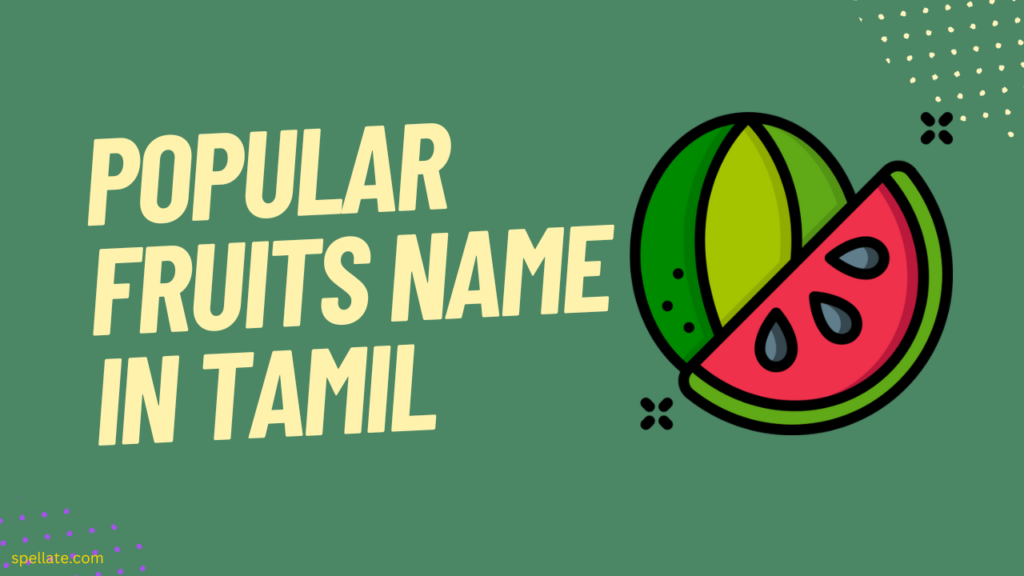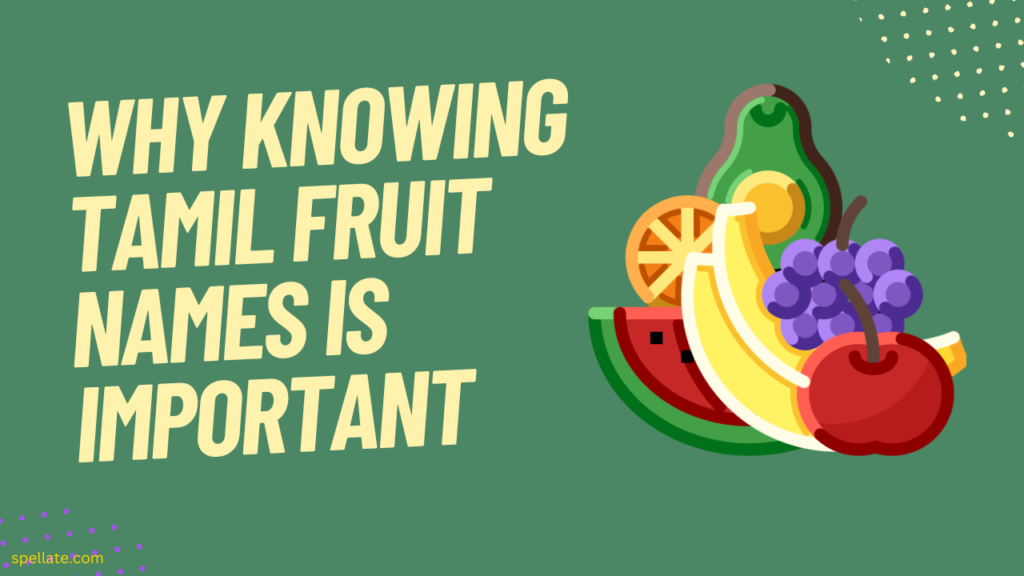The world is full of diverse cultures, each with its own unique language and traditions. Tamil, one of the oldest languages in the world, is spoken by millions of people primarily in the southern Indian state of Tamil Nadu and parts of Sri Lanka. Tamil culture is known for its rich heritage, literature, and delectable cuisine. In this article, we will explore the vibrant world of fruits through the lens of the Tamil language.
We will uncover the various fruits name in Tamil, shedding light on the intriguing and colorful vocabulary that Tamil speakers use to describe these delicious and nutritious gifts of nature. Whether you are a language enthusiast, a traveler, or simply curious about different cultures, this journey into the world of fruits in Tamil is sure to captivate your senses and expand your knowledge. So let’s dive in and discover the melodic and exotic names of fruits in the Tamil language!
- Popular fruits name in Tamil
- 1. Mango – மாம்பழம் (Maampazham)
- 2. Banana – வாழைப்பழம் (Vazhaipazham):
- 3. Apple – ஆப்பிள் (Āppiḷ):
- 4. Orange – ஆரஞ்சு (Aranju):
- 5. Pineapple – அன்னாசி (Annanasi):
- 6. Grapes – திராட்சை (Thiratchai):
- 7. Watermelon – தர்பூசணி (Tarbūc̣aṇi):
- 8. Papaya – பப்பாளி (Pappāḷi):
- 9. Pomegranate – மாதுளை (Maathulai):
- 10. Guava – கொய்யா (Koyya):
- 11. Jackfruit – பலாப்பழம் (Palāpazham):
- 12. Strawberry – ஸ்ட்ராபெரி (Sṭrāperī):
- 13. Kiwi – கீவி (Kīvi):
- 14. Avocado – ஆவகாடோ (Āvakāṭō):
- 15. Coconut – தேங்காய் (Thēngāy):
- 16. Lemon – எலுமிச்சை (Elumichai):
- 17. Mango (unripe) – மாவு (Maavu):
- 18. Custard apple – சீதாப்பழம் (Sīthāpazham):
- 19. Fig – அத்திப்பழம் (Aththipazham):
- 20. Plum – நெல்லிக்காய் (Nellikkai):
- List of 50 fruit names in Tamil
Popular fruits name in Tamil

Tamil Nadu, a state in southern India, is known for its rich culture and heritage. The Tamil language has been in use for over 2000 years and is spoken by millions of people worldwide. One of the interesting aspects of Tamil culture is the variety of fruits that are commonly consumed. In this article, we will take a look at some of the popular fruits name in Tamil.
1. Mango – மாம்பழம் (Maampazham)
In Tamil, the word for mango is “மாம்பழம்” (Maampazham). The term “மாம்பு” (Maambu) refers to a type of tree, and “பழம்” (Pazham) means fruit. When combined, they form the word “மாம்பழம்” (Maampazham), which represents the luscious and tropical fruit mango.
2. Banana – வாழைப்பழம் (Vazhaipazham):
The Tamil word for banana is “வாழைப்பழம்” (Vazhaipazham). “வாழை” (Vazhai) refers to the plantain or banana plant, and “பழம்” (Pazham) denotes fruit. Combining these words gives us “வாழைப்பழம்” (Vazhaipazham), representing the delicious and versatile fruit that is commonly consumed in various forms.
3. Apple – ஆப்பிள் (Āppiḷ):
The Tamil name for apple is “ஆப்பிள்” (Āppiḷ). Since apples are not native to India, the Tamil term “ஆப்பிள்” (Āppiḷ) is an adaptation of the English word “apple.” It is pronounced similarly to its English counterpart, making it easier for Tamil speakers to refer to this popular fruit.
4. Orange – ஆரஞ்சு (Aranju):
In Tamil, the fruit orange is referred to as “ஆரஞ்சு” (Aranju). This term is believed to have been borrowed from the Portuguese word “laranja,” which means orange. Over time, it has become integrated into the Tamil language as “ஆரஞ்சு” (Aranju) to represent this citrus fruit.
5. Pineapple – அன்னாசி (Annanasi):
The Tamil name for pineapple is “அன்னாசி” (Annanasi). The term “அன்னா” (Anna) translates to fragrant, and “சி” (Si) means fruit. Thus, “அன்னாசி” (Annanasi) represents the sweet and aromatic tropical fruit, pineapple.
6. Grapes – திராட்சை (Thiratchai):
In Tamil, grapes are known as “திராட்சை” (Thiratchai). The term “திராட்சை” (Thiratchai) is derived from the Sanskrit word “द्राक्षा” (Draksha), which also means grapes. It’s a term that has been adapted into Tamil to describe the clusters of juicy and succulent grapes.
7. Watermelon – தர்பூசணி (Tarbūc̣aṇi):
In Tamil, watermelon is known as “தர்பூசணி” (Tarbūc̣aṇi). The term “தர்பூசணி” (Tarbūc̣aṇi) is believed to have been borrowed from Persian or Arabic origins. It represents the large, juicy fruit with a high water content that we commonly know as watermelon.
8. Papaya – பப்பாளி (Pappāḷi):
The Tamil name for papaya is “பப்பாளி” (Pappāḷi). This term is thought to be derived from the Sanskrit word “पपालम्” (Papālam). Over time, it has become assimilated into Tamil as “பப்பாளி” (Pappāḷi) to represent the tropical fruit, papaya.
9. Pomegranate – மாதுளை (Maathulai):
In Tamil, pomegranate is called “மாதுளை” (Maathulai). The term “மாதுளை” (Maathulai) is derived from the Sanskrit word “मातुलुङ्ग” (Mātuluṅga), which also means pomegranate. It represents a vibrant and juicy fruit with numerous seeds.
10. Guava – கொய்யா (Koyya):
In Tamil, guava is referred to as “கொய்யா” (Koyya). The term “கொய்யா” (Koyya) represents the fruit we commonly known as guava. It beautifully captures the essence of this tropical fruit with its unique flavor and fragrant aroma.
11. Jackfruit – பலாப்பழம் (Palāpazham):
The Tamil name for jackfruit is “பலாப்பழம்” (Palāpazham). The term “பலா” (Pala) denotes jackfruit, and “பழம்” (Pazham) means fruit. When combined, they form the word “பலாப்பழம்” (Palāpazham), representing the large and flavorful tropical fruit known as jackfruit.
12. Strawberry – ஸ்ட்ராபெரி (Sṭrāperī):
The Tamil name for strawberry is “ஸ்ட்ராபெரி” (Sṭrāperī). Since strawberries are not native to India, the Tamil name “ஸ்ட்ராபெரி” (Sṭrāperī) is an adaptation of the English word “strawberry.” It is pronounced similarly to its English counterpart, allowing Tamil speakers to refer to this popular berry fruit.
13. Kiwi – கீவி (Kīvi):
In Tamil, the fruit kiwi is known as “கீவி” (Kīvi). The Tamil name for kiwi is derived from its English counterpart. It allows Tamil speakers to refer to this exotic fruit using a term that closely resembles its original name.
14. Avocado – ஆவகாடோ (Āvakāṭō):
The Tamil name for avocado is “ஆவகாடோ” (Āvakāṭō). This name is an adaptation of the English word “avocado” and has been assimilated into the Tamil language. It allows Tamil speakers to refer to this popular fruit without a significant deviation from its original name.
15. Coconut – தேங்காய் (Thēngāy):
In Tamil, coconut is referred to as “தேங்காய்” (Thēngāy). The term “தேங்காய்” (Thēngāy) represents the fruit of the coconut palm. It is an integral part of Tamil culture, cuisine, and daily life, as the coconut tree holds great significance in Tamil Nadu and other Tamil-speaking regions.
16. Lemon – எலுமிச்சை (Elumichai):
In Tamil, lemon is referred to as “எலுமிச்சை” (Elumichai). The term “எலுமிச்சை” (Elumichai) represents the citrus fruit lemon. It is a commonly used ingredient in Tamil cuisine and known for its tangy flavor and aromatic qualities.
17. Mango (unripe) – மாவு (Maavu):
The Tamil name for unripe mango is “மாவு” (Maavu). This term specifically refers to the unripe or raw stage of the mango fruit. It is often used in pickles, chutneys, and other dishes in Tamil cuisine.
18. Custard apple – சீதாப்பழம் (Sīthāpazham):
The Tamil name for the custard apple is “சீதாப்பழம்” (Sīthāpazham). The term “சீதா” (Sīthā) denotes custard apple, and “பழம்” (Pazham) means fruit. When combined, they form the word “சீதாப்பழம்” (Sīthāpazham), representing the creamy and sweet fruit known as custard apple.
19. Fig – அத்திப்பழம் (Aththipazham):
In Tamil, fig is known as “அத்திப்பழம்” (Aththipazham). The term “அத்தி” (Aththi) refers to the fig tree, and “பழம்” (Pazham) means fruit. When combined, they form the word “அத்திப்பழம்” (Aththipazham), representing the unique fruit known as fig.
You May Also Like
20. Plum – நெல்லிக்காய் (Nellikkai):
The Tamil name for plum is “நெல்லிக்காய்” (Nellikkai). The term “நெல்லி” (Nelli) refers to the Indian gooseberry, which has a similar appearance to plums. In Tamil Nadu, the term “நெல்லிக்காய்” (Nellikkai) is commonly used to refer to plums as well.
List of 50 fruit names in Tamil

Tamil is a Dravidian language spoken predominantly in the Indian state of Tamil Nadu. It has a rich cultural heritage and boasts an extensive vocabulary that includes several indigenous words for fruits. The Tamil language is unique in its phonetic structure, which enables it to accommodate a vast array of sounds, making it ideal for naming different fruits.
The list of 50 fruits name in Tamil includes well-known fruits such as mango, banana, papaya, and watermelon. The list also features lesser-known but equally delicious fruits like jackfruit, custard apple, and star fruit. Each fruit on the list has a unique name in Tamil that reflects its distinct taste and appearance.
| No | English | Tamil |
| 1 | Apple | ஆப்பிள் (Āppiḷ) |
| 2 | Banana | வாழைப்பழம் (Vāḻaippaḻam) |
| 3 | Mango | மாம்பழம் (Māmpaḻam) |
| 4 | Orange | ஆரஞ்சு (Ārañcu) |
| 5 | Pineapple | அன்னாசி (Annāci) |
| 6 | Grapes | திராட்சை (Tirāṭcai) |
| 7 | Watermelon | தர்பூசணி (Tarbūcaṇi) |
| 8 | Papaya | பப்பாளி (Pappāḷi) |
| 9 | Pomegranate | மாதுளை (Mātuḷai) |
| 10 | Guava | கொய்யா (Koyyā) |
| 11 | Jackfruit | பலாப்பழம் (Palāppaḻam) |
| 12 | Strawberry | ஸ்ட்ராபெரி (Sṭrāperi) |
| 13 | Kiwi | கீவி (Kīvi) |
| 14 | Avocado | ஆவகாடோ (Āvakāṭō) |
| 15 | Coconut | தேங்காய் (Tēṅkāy) |
| 16 | Lemon | எலுமிச்சை (Elumiccai) |
| 17 | Mango (unripe) | மாவு (Māvu) |
| 18 | Custard apple | சீதாப்பழம் (Sītāppaḻam) |
| 19 | Fig | அத்திப்பழம் (Aththippaḻam) |
| 20 | Plum | நெல்லிக்காய் (Nellikkāy) |
| 21 | Peach | பீச்சு (Pīccu) |
| 22 | Pear | பேரி (Pēri) |
| 23 | Raspberry | ராஸ்பெரி (Rāsperi) |
| 24 | Blueberry | பூன்குழம்பிலை (Pūṉkuzambilai) |
| 25 | Blackberry | காற்பழம் (Kāṟpaḻam) |
| 26 | Lychee | பன்னீர்ப்பழம் (Pannīrpaḻam) |
| 27 | Passion fruit | பாசியாப்பிளவுட்பழம் (Pāciyāppiḷavuṭpaḻam) |
| 28 | Kiwifruit | கீவிப்பழம் (Kīvippaḻam) |
| 29 | Dragon fruit | திராகன்பழம் (Tirākaṇpaḻam) |
| 30 | Apricot | சத்தாம்பழம் (Cattāmpaḻam) |
| 31 | Cherry | செர்ரி (Serrī) |
| 32 | Date | பேரிச்சம்பழம் (Pēriccamppaḻam) |
| 33 | Elderberry | எல்டர்பெரி (Elṭarperi) |
| 34 | Gooseberry | நெல்லி (Nelli) |
| 35 | Guelder rose | கேல்டர்ரோஸ் (Kēlṭarrōs) |
| 36 | Jamun | நாவல் பழம் (Nāval paḻam) |
| 37 | Kiwano | கீவானோ (Kīvāṉō) |
| 38 | Litchi | லிச்சி (Licchi) |
| 39 | Longan | லாங்கன் (Lāṅkaṉ) |
| 40 | Mandarin | மண்டரின் (Maṇṭariṉ) |
| 41 | Mulberry | முல்பெரி (Mulpēri) |
| 42 | Olive | ஆலிவ் (Āliv) |
| 43 | Persimmon | சிம்மாம்பழம் (Cimmāmpaḻam) |
| 44 | Raspberry | ராச்பெர்ரி (Rāsperri) |
| 45 | Star fruit | தாராப்பழம் (Tārāppaḻam) |
| 45 | Tamarind | புளி (Puli) |
| 47 | Cranberry | கிரேன்பெரி (Krēṇperi) |
| 48 | Walnut | அக்கரை (Akkarai) |
| 49 | Cashew | முந்திரி (Mundiri) |
| 50 | Hazelnut | அல்மாண்டி (Almāṇṭi) |
| 51 | Pistachio | பிஸ்தா (Pistā) |
Why knowing Tamil fruit names is important

Tamil is a popular South Indian language spoken by millions of people around the world. Tamil culture is deeply rooted in agriculture, and as such, it is no surprise that the language has a rich vocabulary for fruits and vegetables. Knowing these fruits name in Tamil can be incredibly important, especially for those who work in agriculture or gardening.
1. Communication:
If you are in a Tamil-speaking region or interacting with Tamil-speaking individuals, knowing the names of fruits in Tamil will enable effective communication. It allows you to ask for specific fruits, understands fruit-related information, and engage in conversations about fruits and their qualities.
2. Cultural appreciation:
Tamil Nadu and other Tamil-speaking regions have a rich culinary tradition that heavily incorporates fruits. By learning fruits name in Tamil, you can better appreciate and understand the local cuisine and cultural practices surrounding fruits. It allows you to explore traditional recipes, food festivals, and culinary experiences.
3. Shopping and dining:
Knowing Tamil fruit names help during shopping trips to local markets, supermarkets, or fruit stalls. You can easily identify and select the fruits you desire, ensuring you get the right variety and quality. It also assists in ordering fruit-based dishes or juices when dining out at Tamil restaurants.
4. Health benefits:
Fruits are a crucial part of a healthy diet, providing essential nutrients, vitamins, and antioxidants. Knowing fruits name in Tamil empowers you to make informed choices and incorporate a wide range of fruits into your daily meals. You can explore local fruits and take advantage of their nutritional benefits.
5. Building connections:
Learning Tamil fruit names allow you to connect with Tamil-speaking individuals on a personal level. It shows your interest in their language and culture, fostering goodwill and creating opportunities for cultural exchange. It can also help you build relationships, make new friends, and engage in conversations about local produce.
Final Thoughts
In conclusion, learning the names of fruits in Tamil is highly beneficial for various reasons. It enables effective communication, allowing you to interact confidently in Tamil-speaking regions and engage in conversations about fruits. Knowing fruits name in Tamil also deepens your cultural appreciation by connecting you to the culinary traditions and practices surrounding fruits in Tamil Nadu and other Tamil-speaking areas.
Practically, this knowledge aids in shopping for fruits, ordering fruit-based dishes, and making healthy choices in daily meals. It empowers you to explore local markets, supermarkets, and restaurants with confidence, ensuring you can select the desired fruits and enjoy the nutritional benefits they offer.
Moreover, knowing Tamil fruit names demonstrates your interest in the language and culture, fostering connections with Tamil-speaking individuals. It opens doors for cultural exchange, building relationships, and creating opportunities for meaningful conversations.
By understanding fruits name in Tamil, you gain a deeper insight into the language’s rich vocabulary and its connection to the diverse range of fruits found in Tamil-speaking regions. It enhances your language skills, cultural understanding, and overall experiences in Tamil Nadu and Tamil-speaking communities.
FAQs
How can I learn fruit names in Tamil?
You can learn fruit names in Tamil through various resources. Online dictionaries, language learning websites, Tamil language apps, and local language classes can provide translations and pronunciations. Additionally, interacting with native Tamil speakers and exploring Tamil literature can help expand your vocabulary.
Are there different names for fruits in different regions of Tamil Nadu?
Yes, there might be variations in fruit names across different regions of Tamil Nadu. Certain fruits may have regional dialects or local names specific to particular areas. It is always beneficial to learn the common names as well as the regional names if you plan to visit a specific area.
Are there any specific fruit names used in religious or cultural contexts in Tamil Nadu?
Yes, Tamil Nadu has a rich cultural heritage, and some fruits hold special significance in religious or cultural contexts. For example, certain fruits are associated with specific festivals or rituals. Exploring Tamil literature, religious texts, and cultural practices can provide insights into such specific fruit associations.
